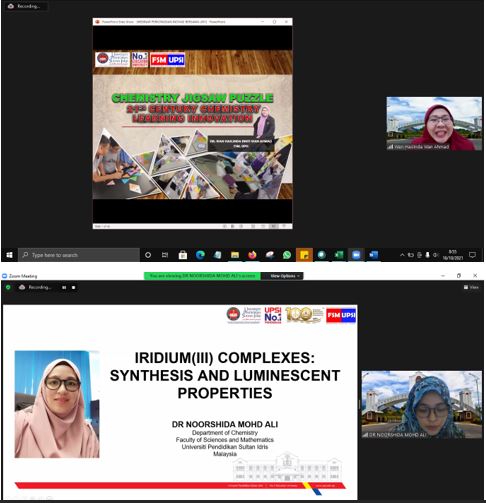 Bahasa Indonesia
Bahasa Indonesia English
English
You are here
Webinar Series #6 Chemistry Education Department, 2021

Saturday, October 16, 2021, the Department of Chemistry Education, Faculty of Mathematics and Natural Sciences, UNY, held a Webinar Series #6 by inviting expert speakers in the fields of chemistry and education. The webinar, which was held online via Zoom Meeting, was attended by 132 participants including teachers, students, lecturers, and practitioners in the fields of chemistry and education. Dr. Retno Arianingrum, as Deputy Chair of the Chemistry Education Department, FMIPA UNY, gave her speech as part of the opening of this Webinar Series #6. On this occasion, the Department of Chemistry Education, Faculty of Mathematics and Natural Sciences, UNY, presented Dr. Noorshida Mohd Ali and Dr. Wan Haslinda Wan Ahmad, from Sultan Idris Education University, Malaysia.
The first material was delivered by Dr. Wan Haslinda Wan Ahmad with the title Chemistry Jigsaw Puzzle – 21st Century Chemistry Learning Innovation. Hopefully those who study science, especially chemistry believe that chemistry is an abstract concept, so that students cannot memorize the material optimally. Based on several journals or references, collaborative activities can make students learn chemistry and improve students' understanding. The use of puzzle games provides positive comments to record information, think logically and think higher. Puzzle as an innovation of teaching aids, apart from game based learning as an approach, hereinafter referred to as Chemistry Jigsaw Puzzle (CJP). A set of CJP consists of various shapes and colors. This CJP is equipped with 163 questions which are divided into 11 levels. This CJP can be played by a minimum of 2 players. The response of students after taking chemistry lessons with CJP was very positive, they were easier to understand the material because learning was done with fun.
As for Dr. Noorshida Mohd Ali delivered the second material in the field of inorganic chemistry with the title Iridium(II) Complexes: Synthesis and Luminescent Properties. Until now, designing red emitters has been a great achievement, but developing and innovating highly efficient, durable blue emitters has been a challenge. the material used to produce OLED blue light degrades rapidly compared to other colors which removes color balance and reduces the overall brightness of the display or lighting device. The research he did was related to previous research. Luminescent cyanometallates as components of supramolecular assemblies. Binding of a kinetic inert (Re(phen)CO3) fragment to one or both cyanides [Ir(F2ppy)2(CN)2[ to produce dinucleic or trinucleic IrRe units IrRe2 Ir species acting as energy donors.
The interactive discussion after the presentation of the material indicated that the material presented attracted participants' interest in developing learning and research. With the implementation of the Webinar Series #6, it is hoped that it can be a learning tool to jointly prepare for innovative learning. In addition, innovative chemical research can support the development of science. The implementation of the Webinar Series #6 will be the last series in 2021 which will be held by the Department of Chemistry Education, Faculty of Mathematics and Natural Sciences, UNY.
Sistem Informasi
Kontak Kami
Program Studi Pendidikan Kimia
FMIPA Universitas Negeri Yogyakarta
Gedung Dekanat D.07 FMIPA UNY
Kampus Karangmalang Yogyakarta 55281
Telp. (0274)586168 Pes. 115
Email: pend_kimia@uny.ac.id
Copyright © 2025,
